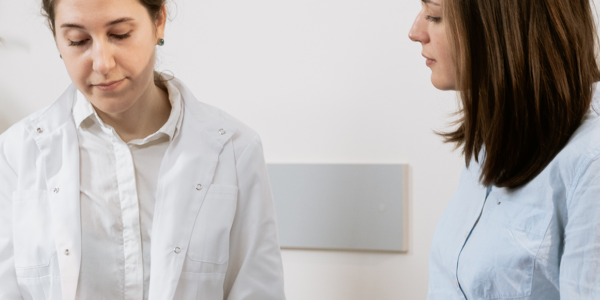Key Takeaways: Patient-Centered Care
- Patient-centered care (PCC) is a care model that prioritizes patient needs, preferences, and values throughout the care experience.
- It improves outcomes, reduces unnecessary tests, and boosts patient satisfaction.
- Tools like OhMD enable efficient, personalized communication, making PCC more scalable and effective.
- Even small practices can adopt this model by focusing on access, empathy, coordination, and technology.
When patients walk into your office, you want them to feel immediately at-ease. That’s why you have comfortable seating, friendly front desk staff, and magazines to pass the time. You may not realize this, but you are already taking some of the first steps to engaging in patient-centered care.
As you can imagine, patients want to have a personal relationship with their providers. This includes having an open line of empathetic communication with their medical practitioner. Although this is easier said than done, it is vitally important nonetheless.
A study published by the Journal of the American Board of Family Medicine reviewed patient outcomes when providers practiced person centered care. They found that practices using patient-centered care are linked to better patient outcomes, undergo fewer costly and time-consuming tests, and have lower medical bills.
Prioritizing patient centered care must be at the forefront of medicine. Take the first step to making this possible at your practice by learning more about what patient centered care really is.
What is Patient-Centered Care?
Patient-centered care is a healthcare approach that puts the patient at the core of every decision. It means more than being friendly. It means designing systems, communication, and clinical workflows around the unique needs, values, and preferences of patients.
The National Academy of Medicine defines patient-centered care as “providing care that is respectful of, and responsive to, individual patient preferences, needs and values, and ensuring that patient values guide all clinical decisions.”
In practice, this means everything from offering flexible appointment options to encouraging shared decision-making with patients and their families. It’s about shifting from a provider-first to a patient-first mindset—and building stronger partnerships along the way.
Core Principles of Patient-Centered Care
Four foundational principles typically define a patient-centered approach:
Care is accessible
Fundamentally, patient centered care is about making sure that the right care is provided at the right time and in the right place. Much like how people would rate a restaurant, they tend to base their patient experience on factors like comfort, friendly staff, and timeliness.
It can be undoubtedly difficult to accommodate patient schedules and preferences. Inconsistent or non-traditional work hours can complicate accommodating patient appointment requests. But try putting yourself in the shoes of those patients. Maybe they don’t have PTO and they cannot afford to take unpaid time off for an appointment. Imagine how happy they would be to hear that you are offering evening or weekend hours. Even more, imagine their reaction if they find out that they can conduct their appointment via a telehealth visit. Now they manage their medical needs from wherever is most convenient for them.
This is just one example of making care accessible to all people. It is much easier said than done, but working towards the goal of person centered care will make all the difference for those you treat.
Respect for patient and family preferences
Interacting with a variety of personalities and values comes with being a healthcare professional. These may be influenced by cultural traditions, socioeconomic status, education level, and various other factors. One way to show that you care about your patients is to respect and carry out these preferences.
To keep yourself on track, remember that patients and family members are a valuable part of the care team. In many cases, the presence of family members in a care setting can be encouraged. Part of respecting familial preferences requires allowing family members to help the patient make the right decision for them.
Coordination of care
Ideally, patients would like to take care of all of their medical needs in one place, during one visit. Although this is not always possible, being able to coordinate care at your practice will make all the difference in the patient experience and likely improve patient satisfaction at your office.
Take, for example, a patient who needs a routine blood panel as well as a check-up on a healing injury. It would be incredibly convenient for that patient to be able to have both of those needs met in one visit. Although this may not be the easiest appointment to coordinate or bill for, the satisfaction of this patient will do wonders for your practice. You may gain new patients through word of mouth or positive online reviews, all thanks to this type of patient centered approach.
Focus on physical and emotional well-being
The term “annual physical” is a little bit misleading. Yes, during these appointments things like vital signs are measured and noted. However, what is often overlooked during these appointments is the socioemotional screening. If you are looking to implement patient centered care at your practice, then preventative care appointments need to attend to both the physical and emotional aspects of wellness.
Benefits of Patient-Centered Care
Adopting a patient-centered care (PCC) model isn’t just good for patients—it’s a smart move for practices aiming to improve clinical outcomes, reduce costs, and strengthen provider-patient relationships. Below are the key benefits of patient-centered care, backed by both research and real-world practice.
1. Better Clinical Outcomes
Multiple studies have shown that patients who are more engaged in their care experience better health outcomes. When patients are invited into the decision-making process, they’re more likely to:
- Follow treatment plans accurately
- Take medications as prescribed
- Report new or worsening symptoms earlier
- Maintain healthier lifestyle habits over time
This is especially important in managing chronic conditions like diabetes, hypertension, or depression. When patients feel heard and supported, they’re more proactive—and providers have the opportunity to intervene before issues escalate.
2. Reduced Unnecessary Testing and Procedures
A more personalized, coordinated approach to care helps avoid duplicate tests, inappropriate treatments, and low-value interventions. In a study published by the Journal of the American Board of Family Medicine, clinics practicing patient-centered care saw reductions in:
- Redundant lab work and imaging
- Specialist referrals that didn’t improve outcomes
- Emergency department visits for non-urgent needs
This not only saves the system money but also spares patients the stress and inconvenience of unnecessary medical encounters.
3. Lower Healthcare Costs
Better communication, streamlined care coordination, and reduced overuse of services all contribute to lower total costs for both patients and health systems. When patients are more involved, there’s less trial-and-error in care plans and more clarity in what’s truly needed.
Payers and providers operating under value-based reimbursement models can especially benefit, as improved patient outcomes and satisfaction are often tied to performance bonuses and cost-sharing savings.
4. Higher Patient Satisfaction and Loyalty
Patients who feel respected and involved are far more likely to stick with a provider or recommend the practice to others. Simple changes like texting patients appointment reminders, following up on care plans, or offering a choice in visit format can have a big impact on patient trust and loyalty.
Using tools like OhMD, which allow for secure two-way texting and asynchronous communication, can significantly improve the patient experience—especially for those who prefer texting over phone calls or portals.
5. Improved Provider Satisfaction and Reduced Burnout
When patients are more engaged and satisfied, the burden on providers often lessens. That’s because:
- There are fewer repeat questions and miscommunications
- Follow-ups are smoother and more effective
- Patients are more informed, which leads to faster decision-making
Additionally, having digital tools in place (like OhMD’s shared inbox and message routing) helps reduce administrative clutter and improve team workflows, giving providers more time to focus on meaningful interactions.
6. Stronger Health Equity
Patient-centered care accounts for differences in language, culture, socioeconomic status, and healthcare literacy. By creating systems that are flexible and respectful of individual needs, practices can reach and retain more diverse populations—especially those who may have previously been underserved or distrustful of the healthcare system.
For example, offering multiple communication formats (text, phone, video) and involving family members in care can help bridge cultural gaps and make care more inclusive.
7. Enhanced Care Coordination
PCC encourages information sharing between all members of a patient’s care team—whether in the same building or across different organizations. Coordinated care reduces the likelihood of gaps in follow-up, conflicting instructions, or delayed diagnoses.
This is especially beneficial for patients navigating complex medical journeys involving specialists, therapy, or home care. Tools like OhMD allow practices to assign follow-up tasks, route incoming messages, and keep everyone aligned in real time.
Examples of Patient-Centered Care
Patient-centered care can take many forms depending on the practice setting, patient population, and available resources. While the philosophy is universal, the day-to-day implementation often comes down to small, meaningful actions that reflect empathy, flexibility, and clear communication.
Here are several real-world examples that illustrate what patient-centered care looks like in practice:
Example 1: Flexible Scheduling for a Working Parent
A pediatric office implements evening and weekend hours after learning that many parents struggle to bring their children in during the workday. One parent, a single mother working two jobs, is relieved to schedule her child’s check-up for a Saturday morning. She also appreciates the ability to confirm appointments or reschedule via text using a platform like OhMD instead of waiting on hold.
This simple accommodation strengthens the relationship between the clinic and the family—and helps ensure the child gets consistent preventive care.
Example 2: Text-Based Communication for Chronic Disease Management
A primary care clinic uses OhMD’s secure texting feature to check in weekly with patients managing hypertension. One patient receives automated reminders to log their blood pressure and manually texts the results back. A nurse reviews the data and provides feedback or flags trends for the doctor.
This asynchronous workflow empowers the patient to take an active role in their care while reducing unnecessary in-person visits.
Example 3: Multilingual Support for an Immigrant Family
An elderly patient and her adult children immigrated recently and are more comfortable speaking Spanish. The front office staff uses bilingual intake forms and offers interpretation services during visits. Discharge instructions are provided in Spanish, and family members are looped into communication via OhMD’s group messaging so they can help manage medications and appointments.
This culturally sensitive approach ensures the patient receives care she understands—and builds trust with her family as active care partners.
Example 4: Coordinated In-Visit Services for Convenience
A family medicine clinic uses visit planning tools to bundle services into one appointment. For example, a 52-year-old patient due for a flu shot, lab work, and a skin check can complete all three in one afternoon visit. The care team coordinates with the lab and nurse in advance to streamline the experience.
Instead of multiple appointments across multiple days, the patient walks out feeling their time is respected and the clinic avoids missed follow-ups.
Example 5: Emotional and Mental Health Screening During a Physical
During an annual physical, a provider notices that the patient seems withdrawn and distracted. Rather than rushing through, the provider asks open-ended questions and uses a standardized mental health screening tool. The patient discloses recent depression and trouble sleeping.
This leads to a referral for behavioral health support and a plan to follow up weekly via secure messages. The provider’s attentiveness uncovers a deeper issue that might have otherwise been missed.
Example 6: Virtual Visit for a Rural Patient
A patient living in a rural area needs to follow up on lab results, but the nearest clinic is over an hour away. Instead of requiring a trip, the provider offers a secure video visit through OhMD. They review the results together, adjust medications, and answer questions, all from the patient’s home.
This reduces travel burden, keeps the patient engaged in their care, and preserves continuity despite geographic barriers.
Example 7: Post-Surgical Follow-Up via Secure Messaging
A patient recovering from knee surgery sends a photo of their incision site and a message about mild swelling using OhMD. Within a few hours, the care team responds to say it looks normal but encourages the patient to call if pain worsens. The patient avoids a costly ER visit, and the provider can document the interaction in the record.
Proactive communication like this builds confidence and helps patients feel supported between visits.
Example 8: Personalized End-of-Life Planning
In a palliative care setting, a team schedules a longer-than-usual visit to review advance care planning with a patient and their family. The provider invites the family to ask questions and discusses the patient’s goals, fears, and preferences. They document everything clearly and share it across the care team so there’s no ambiguity later.
The patient and family leave the appointment with peace of mind, knowing their wishes will be respected.
How Patient-Centered Care Supports Value-Based Healthcare
Value-based care is a reimbursement model that rewards providers for delivering better health outcomes, not more procedures. Patient-centered care is essential to making that shift work.
Why? Because engaged patients are more likely to:
- Adhere to medications and care plans
- Avoid preventable hospitalizations
- Report early signs of complications
- Feel confident managing chronic conditions
When care is personalized and communication is smooth, patients are more active participants in their health—and that translates into measurable cost savings and improved clinical metrics.
Tools like OhMD can help by enabling secure messaging, reminders, patient education, and follow-up, all key elements of keeping patients connected between visits.
Tools That Support Patient-Centered Care
Technology can reduce the administrative burden of PCC and make it more achievable for teams of all sizes.
Some tools that support this approach include:
- Secure text messaging platforms like OhMD: Keep communication clear, fast, and compliant.
- Telehealth software: Offer appointments that fit patient schedules.
- EHR-integrated reminders: Automate appointment follow-ups or medication instructions.
- Patient segmentation and tagging: Keep track of preferences, conditions, and outreach history—OhMD makes this easy with patient tags.
- Digital intake forms and surveys: Let patients share information in advance to streamline visits.
The key is not just using technology, but using it in a way that supports trust, transparency, and ease for both patients and providers.
How to Implement Patient-Centered Care in Your Practice
Patient-centered care doesn’t require a complete overhaul. Start with a few achievable changes:
1. Listen actively
Train staff to make space for patients to voice concerns, ask questions, and express preferences. Use scripting or prompts during visits to encourage dialogue.
2. Expand access
Consider evening or weekend hours, or offer telehealth and asynchronous messaging. Use platforms like OhMD to give patients more flexible options to engage with care teams.
3. Include families and caregivers
Ask patients if they’d like a loved one involved. OhMD’s group messaging feature allows families to be included in communication without compromising privacy.
4. Improve coordination
Use shared digital tools to reduce care silos. Even if you’re not in a large system, platforms like OhMD can help bridge gaps in communication between primary care, specialists, and support staff.
5. Personalize communication
Let patients choose their preferred communication method—whether it’s text, phone call, or video. When patients hear from you in the way they prefer, they’re more likely to stay engaged.
6. Screen holistically
Add quick mental health or social needs questions to annual exams or intake forms. These can help identify deeper needs that might otherwise go unnoticed.
Final Thoughts on Patient-Centered Care
Patient-centered care isn’t just a healthcare philosophy—it’s a practical, proven approach to improving outcomes, lowering costs, and building lasting trust between patients and providers. When care is accessible, respectful, coordinated, and holistic, patients feel empowered to take an active role in their health. And when providers are supported by the right tools and workflows, delivering this level of care becomes not only feasible but sustainable.
Whether you’re in a small private practice or a larger health system, embracing patient-centered care starts with intentional communication and thoughtful design of the patient experience. With solutions like OhMD, providers can streamline outreach, support flexible care models, and strengthen relationships with the people who rely on them most.
Investing in patient-centered care today means delivering better care for every patient—every time.
FAQs About Patient-Centered Care
What’s the difference between patient-centered care and value-based care?
Patient-centered care is a philosophy focused on the experience and preferences of the patient. Value-based care is a payment model that rewards better outcomes and cost-efficiency. PCC supports value-based care by improving adherence, satisfaction, and health outcomes, all of which are tied to value-based metrics.
What are the eight principles of patient-centered care?
While different frameworks exist, the commonly accepted eight principles include:
- Respect for patient preferences and values
- Emotional support
- Physical comfort
- Information and education
- Continuity and transition
- Coordination of care
- Involvement of family and friends
- Access to care
These principles can be woven into every touchpoint of a patient’s experience.
How does this model improve clinical outcomes?
Patient-centered care improves outcomes by increasing engagement, reducing misunderstandings, and encouraging shared decision-making. Patients who feel heard are more likely to follow care plans, take medications, and speak up when symptoms change.
Can small practices use patient-centered care effectively?
Yes. In fact, small practices may have an advantage due to stronger provider-patient relationships. Tools like OhMD level the playing field by giving small teams access to HIPAA-compliant messaging, patient tagging, and telehealth options without the need for complex infrastructure.
What tools help deliver this kind of care?
Secure communication platforms (like OhMD), EHR-integrated workflows, online scheduling, and digital intake forms are all examples. The best tools reduce friction and support timely, personalized communication with patients.
Ease communication between patients and your care team. Learn more about the OhMD patient communication platform!





